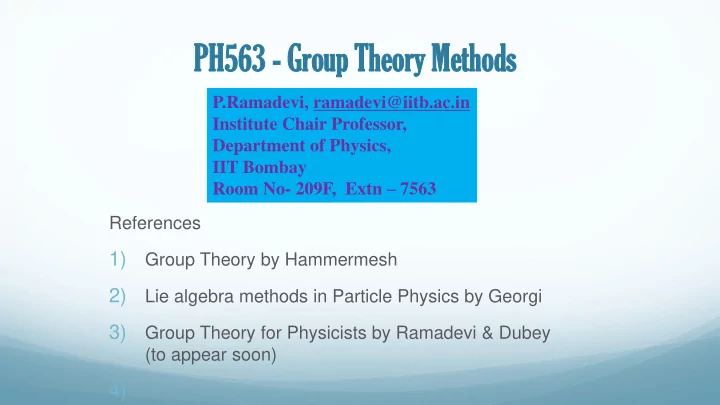

PH56 PH563 3 - Gr Grou oup Theo p Theory Meth ry Methods ods P.Ramadevi, ramadevi@iitb.ac.in Institute Chair Professor, Department of Physics, IIT Bombay Room No- 209F, Extn – 7563 References 1) Group Theory by Hammermesh 2) Lie algebra methods in Particle Physics by Georgi 3) Group Theory for Physicists by Ramadevi & Dubey (to appear soon) 4)
In-Sem + End Sem evaluation 10 marks Quiz in the fourth week of August 20 marks for assignments 30 marks mid-sem 40 marks end-sem 80% attendance compulsory
Syllabus and Plan Discrete Groups (First half of the sem) Cyclic groups, Permutation groups, Point groups,irreducible representations, Great orthogonality theorem, character tables, application in solid state physics Continuous Groups (2 nd half ) Space translation, time translational, rotational symmetries, Introduction to Lie algebras& Groups- SU(2),SU(3), Lorentz group, applications
What is symmetry Take a square and a circle a b d a Rotate by 90 Discrete symm c d b c Rotate by any angle Continous symmetry
Definition What is a Group G: set : {a,b,c,d…} + group operation . Satisfying 4 properties: (1) Closure (2) Identity element (3) Inverse element (4) associative Abelian Group (Commutative) Subgroup , Multiplication table
Examples Example 1 . The set of all integers Z is a group if the group product is taken to be the usual addition of integers. This group is clearly abelian and has an infinite number of elements. Example 2 . The set of all complex numbers C is a group under addition of complex numbers. This group again is abelian and infinite. � Example 3 . The set C − {0} is an infinite abelian group under the usual multiplication of complex numbers. � Example 4. The set of all 2 × 2 matrices with complex entries is an infinite abelian group under matrix addition. What is the nature of the group if matrix multiplication replaces matrix addition in example 4?
Finite group Group with finite number of elements is called finite group. Order of a group: Number of elements denoted by |G| Subgroup: subset satisfying all the four axioms of group Generators: subset of elements whose finite powers give group elements - (i) cyclic group (ii) symmetric group
generators Suppose a group G is generated using generators a,b,c,d. This means all possible words of various powers of these generators are elements of G Cyclic group elements are given by powers of one generator. The group is abelian. Order of the generator is also the order of the cyclic group. Last lecture, we discussed a group of order 4 generated using two generators each of order 2 as well as commuting.
Generators of Klein group Multiplication table a, b are generators satisfying a 2 =b 2 =e; ab=ba Find another group again generated using a,b but satisfying: a 2 = b 3 =e ; ab= b 2 a- Is this group abelian or non-abelian?
Symmetric group Subgroups of this Group?
Subgroups e and G are trivial subgroups In the symmetric group, there are four cyclic subgroups H 1 = {e,a} ; H 2 = {e,b, b 2 } ;H 3 = {e, ab} ; H 4 ={e, ab 2 ) If a is any element of G and H is a subgroup of G, then Ha is a subset of elements in G. We call these subsets as left coset of subgroup G. Similarly a H will be right coset. Left coset of e is the subgroup H itself G = H U Ha U….(Disjoint union of left cosets) Lagrange’s Theorem - |H| divides |G|
Conjugate groups Let H be non-trivial subgroup of G Then a H a^-1 will also be a subgroup conjugate to H If aH a -1 = H for all choices of a, then H is called normal subgroup or invariant subgroup. The left coset of a subgroup will be same as right coset of the subgroup if H is a normal subgroup Find the conjugate subgroups of the symmetric group The set of cosets of a normal subgroup is called factor group.
Conjugacy class Order of g and order of its conjugate element g’ will be same. For the symmetric group, the elements can be disjoint union of three conjugacy classes:
Quaternion group Generators are i, j, k, s such that i 2 =j 2 =k 2 = ijk = s ; s 2 =e Find the group elements of such a group Also decompose the group elements into conjugacy class
Dihedral group D n has 2n elements Generators are r whose order is n and s whose order is 2 . That is., r n = s 2 = e Further sr = r -1 s Find the elements, subgroups, normal subgroup s
Homomorphism Map between two groups Kernel Examples
Symmetric Group Various ways of writing permutations of n objects Group structure Classes and number of elements in the class
SymmetricGroup In cycle form,
odd Order?
Subgroups. Cayley ’ s theorem Every group G of order n is isomorphic with a subgroup H (known as permutation group) of symmetric group We know order 4 groups Find the isomorphism?
class Cycle form doesnot change under conjugation Class will have all elements with same cycle structure No. of elements with same cycle structure
Platonic Solids F = 4, E = 6 F = 6, E = 12 V = 4 ( χ = 2) V = 8 ( χ = 2)
Rotation axes of cube
Recommend
More recommend